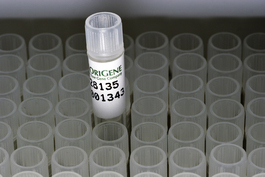RNF146 (NM_001242845) Human Untagged Clone
CAT#: SC331900
RNF146 (untagged) - Homo sapiens ring finger protein 146 (RNF146), transcript variant 3
"NM_001242845" in other vectors (2)
Product Images

Frequently bought together (3)
Other products for "RNF146"
Specifications
| Product Data | |
| Type | Human Untagged Clone |
| Tag | Tag Free |
| Symbol | RNF146 |
| Vector | pCMV6-Entry |
| Sequence Data |
>SC331900 representing NM_001242845.
Blue=Insert sequence Red=Cloning site Green=Tag(s) ATGGCTGGCTGTGGTGAAATTGATCATTCAATAAACATGCTTCCTACAAACAGGAAAGCGAACGAGTCC TGTTCTAATACTGCACCTTCTTTAACCGTCCCTGAATGTGCCATTTGTCTGCAAACATGTGTTCATCCA GTCAGTCTGCCCTGTAAGCACGTTTTCTGCTATCTATGTGTAAAAGGAGCTTCATGGCTTGGAAAGCGG TGTGCTCTTTGTCGACAAGAAATTCCCGAGGATTTCCTTGACAAGCCAACCTTGTTGTCACCAGAAGAA CTCAAGGCAGCAAGTAGAGGAAATGGTGAATATGCATGGTATTATGAAGGAAGAAATGGGTGGTGGCAG TACGATGAGCGCACTAGTAGAGAGCTGGAAGATGCTTTTTCCAAAGGTAAAAAGAACACTGAAATGTTA ATTGCTGGCTTTCTGTATGTCGCTGATCTTGAAAACATGGTTCAATATAGGAGAAATGAACATGGACGT CGCAGGAAGATTAAGCGAGATATAATAGATATACCAAAGAAGGGAGTAGCTGGACTTAGGCTAGACTGT GATGCTAATACCGTAAACCTAGCAAGAGAGAGCTCTGCTGACGGAGCGGACAGTGTATCAGCACAGAGT GGAGCTTCTGTTCAGCCCCTAGTGTCTTCTGTAAGGCCCCTAACATCAGTAGATGGTCAGTTAACAAGC CCTGCAACACCATCCCCTGATGCAAGCACTTCTCTGGAAGACTCTTTTGCTCATTTACAACTCAGTGGA GACAACACAGCTGAAAGGAGTCATAGGGGAGAAGGAGAAGAAGATCATGAATCACCATCTTCAGGCAGG GTACCAGCACCAGACACCTCCATTGAAGAAACTGAATCAGATGCCAGTAGTGATAGTGAGGATGTATCT GCAGTTGTTGCACAGCACTCCTTGACCCAACAGAGACTTTTGGTTTCTAATGCAAACCAGACAGTACCC GATCGATCAGATCGATCGGGAACTGATCGATCAGTAGCAGGGGGTGGAACAGTGAGTGTCAGTGTCAGA TCTAGAAGGCCTGATGGACAGTGCACAGTAACTGAAGTTTAA |
| Restriction Sites | SgfI-MluI |
| ACCN | NM_001242845 |
| Insert Size | 1077 bp |
| OTI Disclaimer | Our molecular clone sequence data has been matched to the reference identifier above as a point of reference. Note that the complete sequence of our molecular clones may differ from the sequence published for this corresponding reference, e.g., by representing an alternative RNA splicing form or single nucleotide polymorphism (SNP). |
| Product Components | The ORF clone is ion-exchange column purified and shipped in a 2D barcoded Matrix tube containing 10ug of transfection-ready, dried plasmid DNA (reconstitute with 100 ul of water). |
| Reconstitution | 1. Centrifuge at 5,000xg for 5min. 2. Carefully open the tube and add 100ul of sterile water to dissolve the DNA. 3. Close the tube and incubate for 10 minutes at room temperature. 4. Briefly vortex the tube and then do a quick spin (less than 5000xg) to concentrate the liquid at the bottom. 5. Store the suspended plasmid at -20°C. The DNA is stable for at least one year from date of shipping when stored at -20°C. |
| Reference Data | |
| RefSeq | NM_001242845.1 |
| RefSeq Size | 2519 bp |
| RefSeq ORF | 1077 bp |
| Locus ID | 81847 |
| UniProt ID | Q9NTX7 |
| Cytogenetics | 6q22.33 |
| Protein Families | Druggable Genome |
| MW | 38.8 kDa |
| Gene Summary | E3 ubiquitin-protein ligase that specifically binds poly-ADP-ribosylated (PARsylated) proteins and mediates their ubiquitination and subsequent degradation. May regulate many important biological processes, such as cell survival and DNA damage response. Acts as an activator of the Wnt signaling pathway by mediating the ubiquitination of PARsylated AXIN1 and AXIN2, 2 key components of the beta-catenin destruction complex. Acts in cooperation with tankyrase proteins (TNKS and TNKS2), which mediate PARsylation of target proteins AXIN1, AXIN2, BLZF1, CASC3, TNKS and TNKS2. Recognizes and binds tankyrase-dependent PARsylated proteins via its WWE domain and mediates their ubiquitination, leading to their degradation. Different ubiquitin linkage types have been observed: TNKS2 undergoes ubiquitination at 'Lys-48' and 'Lys-63', while AXIN1 is only ubiquitinated at 'Lys-48'. May regulate TNKS and TNKS2 subcellular location, preventing aggregation at a centrosomal location. Neuroprotective protein. Protects the brain against N-methyl-D-aspartate (NMDA) receptor-mediated glutamate excitotoxicity and ischemia, by interfering with PAR-induced cell death, called parthanatos. Prevents nuclear translocation of AIFM1 in a PAR-binding dependent manner. Does not affect PARP1 activation (By similarity). Protects against cell death induced by DNA damaging agents, such as N-methyl-N-nitro-N-nitrosoguanidine (MNNG) and rescues cells from G1 arrest. Promotes cell survival after gamma-irradiation. Facilitates DNA repair.[UniProtKB/Swiss-Prot Function] Transcript Variant: This variant (3) differs in the 5' UTR, compared to variant 1. Variants 1-7 encode the same isoform (a). |
Documents
| Product Manuals |
| FAQs |
| SDS |
Resources
{0} Product Review(s)
0 Product Review(s)
Submit review
Be the first one to submit a review
Product Citations
*Delivery time may vary from web posted schedule. Occasional delays may occur due to unforeseen
complexities in the preparation of your product. International customers may expect an additional 1-2 weeks
in shipping.






























































































































































































































































 Germany
Germany
 Japan
Japan
 United Kingdom
United Kingdom
 China
China
